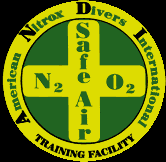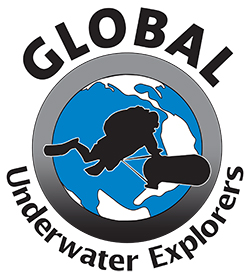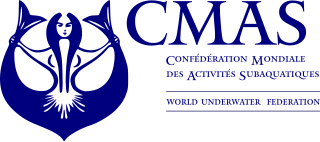Related Research Articles

Trimix is a breathing gas consisting of oxygen, helium and nitrogen and is used in deep commercial diving, during the deep phase of dives carried out using technical diving techniques, and in advanced recreational diving.

Technical diving is scuba diving that exceeds the agency-specified limits of recreational diving for non-professional purposes. Technical diving may expose the diver to hazards beyond those normally associated with recreational diving, and to a greater risk of serious injury or death. The risk may be reduced by appropriate skills, knowledge and experience, and by using suitable equipment and procedures. The skills may be developed through appropriate specialised training and experience. The equipment involves breathing gases other than air or standard nitrox mixtures, and multiple gas sources.

Recreational diver training is the process of developing knowledge and understanding of the basic principles, and the skills and procedures for the use of scuba equipment so that the diver is able to dive for recreational purposes with acceptable risk using the type of equipment and in similar conditions to those experienced during training.

The British Sub-Aqua Club or BSAC has been recognised since 1954 by UK Sport as the national governing body of recreational diving in the United Kingdom.
Scuba Schools International (SSI) is a for-profit organization that teaches the skills involved in scuba diving and freediving, and supports dive businesses and resorts. SSI has over 2,500 authorized dealers, 35 regional centers, and offices all over the world.

Advanced Open Water Diver (AOWD) is a recreational scuba diving certification level provided by several diver training agencies. Agencies offering this level of training under this title include Professional Association of Diving Instructors (PADI), and Scuba Schools International (SSI). Other agencies offer similar training under different titles. Advanced Open Water Diver is one step up from entry level certification as a beginner autonomous scuba diver. A major difference between Autonomous diver equivalent Open Water Diver (OWD) certification and AOWD is that the depth limit is increased from 18 to 30 metres.
Technical Diving International (TDI) claims to be the largest technical diving certification agency in the world, and one of the first agencies to offer mixed gas and rebreather training. TDI specializes in more advanced Scuba diving techniques, particularly diving with rebreathers and use of breathing gases such as trimix and heliox.

American Nitrox Divers International was founded by Ed Betts and Dick Rutkowski in 1988.

The Federazione Italiana Attività Subacquee (FIAS) is an Italian non-profit diver training organization. It is a member of:

Global Underwater Explorers (GUE) is a scuba diving organization that provides education within recreational, technical, and cave diving. It is a nonprofit membership organization based in High Springs, Florida, United States.

Confédération Mondiale des Activités Subaquatiques (CMAS) is an international federation that represents underwater activities in underwater sport and underwater sciences, and oversees an international system of recreational snorkel and scuba diver training and recognition. It is also known by its English name, the World Underwater Federation, and its Spanish name, Confederación Mundial De Actividades Subacuáticas. Its foundation in Monaco during January 1959 makes it one of the world's oldest underwater diving organisations.

A Diving certification or C-card is a document recognizing that an individual or organization authorized to do so, "certifies" that the bearer has completed a course of training as required by the agency issuing the card. This is assumed to represent a defined level of skill and knowledge in underwater diving. Divers carry a qualification record or certification card which may be required to prove their qualifications when booking a dive trip, hiring scuba equipment, filling diving cylinders or in the case of professional divers, seeking employment.

Open Water Diver (OWD) is an entry-level autonomous diver certification for recreational scuba diving. Although different agencies use different names, similar entry-level courses are offered by all recreational diving agencies and consist of a combination of knowledge development (theory), confined water dives and open water dives (experience) suitable to allow the diver to dive on open circuit scuba, in open water to a limited depth and in conditions similar to those in which the diver has been trained or later gained appropriate experience, to an acceptable level of safety.

Dive RAID International is a dive training organization which was founded in 2007 by Barry Coleman to support diver training for the Poseidon Mk VI Discovery Rebreather. It has since extended its scope to include open circuit scuba training and training for both recreational and technical diving sectors as well as snorkeling and freediving.

Autonomous diver is an international minimum standard for entry level recreational scuba diver certification. It describes the minimum requirements for basic training and certification for recreational scuba divers in international standard ISO 24801-2 and the equivalent European Standard EN 14153-2. Various organizations offer training that meets the requirements of the Autonomous Diver standard. A certification which corresponds to Autonomous Diver allows for independent diving with a dive buddy in open water. Most training organizations do not recommend exceeding a depth of 18 or 20 meters at this level of certification. After completion of this certification the training can be extended to a dive leader to ISO 24801-3 or an intermediate not defined by international standards.

Supervised diver specifies the training and certification for recreational scuba divers in international standard ISO 24801-1 and the equivalent European Standard EN 14153-1. Various diving organizations offer diving training that meets the requirements of the Supervised Diver. A diving certification which corresponds to the Supervised Diver allows for recreational diving under the direct supervision of a divemaster or recreational diving instructor in open water. Most diving organizations recommend not to exceed a diving depth of 10 to 12 metres. After the successful completion of a training equivalent to the Supervised diver, training can be extended to the Autonomous diver certification level.
Dive leader is the title of an internationally recognised recreational diving certification. The training standard describes the minimum requirements for dive leader training and certification for recreational scuba divers in international standard ISO 24801-3 and the equivalent European Standard EN 14153-3. Various organizations offer training that meets the requirements of the dive leader standard. Some agencies use the title "Dive Leader" for their equivalent certification, but several other titles are also used, "Divemaster" may be the most widespread, but "Dive Supervisor" is also used, and should not be confused with the very different status and responsibilities of a professional diving supervisor. CMAS affiliates certifications which meet the requirements of CMAS 3-star diver should meet the standard by default. The occupation of a dive leader is also known as "dive guide", and is a specialist application of a "tour guide".

The history of scuba diving is closely linked with the history of the equipment. By the turn of the twentieth century, two basic architectures for underwater breathing apparatus had been pioneered; open-circuit surface supplied equipment where the diver's exhaled gas is vented directly into the water, and closed-circuit breathing apparatus where the diver's carbon dioxide is filtered from the exhaled breathing gas, which is then recirculated, and more gas added to replenish the oxygen content. Closed circuit equipment was more easily adapted to scuba in the absence of reliable, portable, and economical high pressure gas storage vessels. By the mid-twentieth century, high pressure cylinders were available and two systems for scuba had emerged: open-circuit scuba where the diver's exhaled breath is vented directly into the water, and closed-circuit scuba where the carbon dioxide is removed from the diver's exhaled breath which has oxygen added and is recirculated. Oxygen rebreathers are severely depth limited due to oxygen toxicity risk, which increases with depth, and the available systems for mixed gas rebreathers were fairly bulky and designed for use with diving helmets. The first commercially practical scuba rebreather was designed and built by the diving engineer Henry Fleuss in 1878, while working for Siebe Gorman in London. His self contained breathing apparatus consisted of a rubber mask connected to a breathing bag, with an estimated 50–60% oxygen supplied from a copper tank and carbon dioxide scrubbed by passing it through a bundle of rope yarn soaked in a solution of caustic potash. During the 1930s and all through World War II, the British, Italians and Germans developed and extensively used oxygen rebreathers to equip the first frogmen. In the U.S. Major Christian J. Lambertsen invented a free-swimming oxygen rebreather. In 1952 he patented a modification of his apparatus, this time named SCUBA, an acronym for "self-contained underwater breathing apparatus," which became the generic English word for autonomous breathing equipment for diving, and later for the activity using the equipment. After World War II, military frogmen continued to use rebreathers since they do not make bubbles which would give away the presence of the divers. The high percentage of oxygen used by these early rebreather systems limited the depth at which they could be used due to the risk of convulsions caused by acute oxygen toxicity.
Recreational scuba certification levels are the levels of skill represented by recreational scuba certification. Each certification level is associated with a specific training standard published by the certification agency, and a training programme associated with the standard., though in some cases recognition of prior learning can apply. These levels of skill can be categorised in several ways:
References
- ↑ "About Us". www.protecdive.com. Retrieved 27 March 2023. This information was retrieved from the ProTec website, subpage about us, and matches with the German trademark register
- ↑ M. Mercè Santmartí i Miró (2011-06-27). "Resolució AAM/1814/2011, de 27 de juny, per la qual s'estableixen les equivalències entre qualificacions oficials de busseig d'esbarjo i les qualificacions de busseig de Professional Technical Diving". Diari Oficial de la Generalitat de Catalunya, documentId=585388 (in Catalan). Retrieved 2022-04-26.
{{cite web}}: CS1 maint: url-status (link) - ↑ "The CDWS recognize the following training agencies". www.cdws.travel. Retrieved 2022-04-26.
{{cite web}}: CS1 maint: url-status (link) - ↑ "DIN-EN-ISO Registration Number RX004". TÜV Rheinland - DIN CERTCO - Certificates and Registrations. 2018-10-16. Retrieved 2022-04-26.
{{cite web}}: CS1 maint: url-status (link) - ↑ "DIN-EN-ISO Registration Number RX005". TÜV Rheinland - DIN CERTCO - Certificates and Registrations. 2018-10-16. Retrieved 2022-04-26.
{{cite web}}: CS1 maint: url-status (link) - ↑ "ISO 11121:2017". ISO. Retrieved 2022-04-27.
- ↑ "ISO 24801-1:2014". ISO. Retrieved 2022-04-27.
- ↑ "ISO 24801-2:2014". ISO. Retrieved 2022-04-27.
- ↑ Massay, Philippe (2017). Manuel de formation pour plongeur ProTec 1* et ProTec OWD (in French). France, Belgium. p. 76.
- ↑ Klimpel, Manfred (2014). Manual ProTec 2** Diver / Advanced Open Water. International: KDD Digital. p. 136. ISBN 978-3-00-040784-0.
- ↑ "ISO 24801-3:2014". ISO. Retrieved 2022-04-27.
- ↑ "ISO 24802-1:2014". ISO. Retrieved 2022-04-27.
- ↑ "ISO 24802-2:2014". ISO. Retrieved 2022-04-27.
- ↑ Kaiser-Hagenow, Ina (2013). Manual del Buceador de Rescate y Primeros auxillos / ProTec (in Spanish). Spanish: KDD Digital. p. 98.
- ↑ "ISO 11107:2009". ISO. Retrieved 2022-04-27.
- ↑ Hirschmann, Gerhard (2002). Nitrox diver manual (Kursbuch zum Nitroxtauchen für Sporttaucher) / ProTec Professional Technical Diving (in German) (6th ed.). Europe, Germany: Alpha-Verlag. p. 52. ISBN 3-932470-01-X.
- 1 2 "ISO 13293:2012". ISO. Retrieved 2022-04-27.
- ↑ Gerhard, Hirschmann (2000). Trimix diver manual [Arbeitsbuch zum Tieftauchen mit Trimix] / ProTec Professional Technical Diving (in German) (3rd ed.). Europe, Germany: Alpha-Verlag. p. 64. ISBN 3-932470-04-4.
- ↑ Hirschmann, Gerhard (2000). Extended range workbook (Arbeitsbuch zum Tieftauchen für Fortgeschrittene) / ProTec Professional Technical Diving (in German) (4th ed.). Europe, Germany: Alpha-Verlag. p. 98. ISBN 3-932470-03-6.
- ↑ Tolksdorf, Martin (2007). Fascination Cave Diving [ProTec Professional Technical & Rec. Diving] (in English and German) (2nd ed.). Europe, Germany: Alpha Verlag. p. 204. ISBN 978-3-932470-16-5.
- ↑ Gerhard, Hirschmann (2000). Rebreather diver manual [Kursbuch zum Tauchen mit Kreislaufgeräten] / ProTec, Professional Technical Diving (in German) (3rd ed.). Europe, Germany: Alpha-Verlag. p. 62. ISBN 3-932470-02-8.